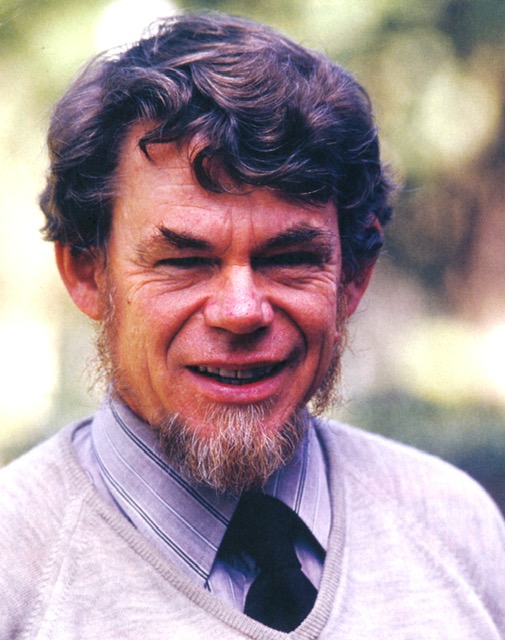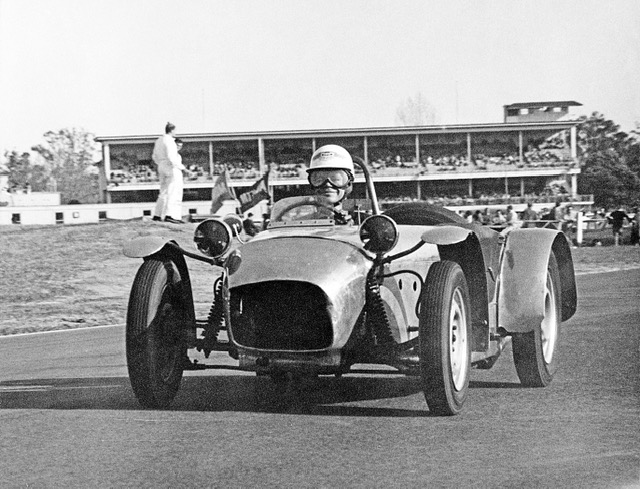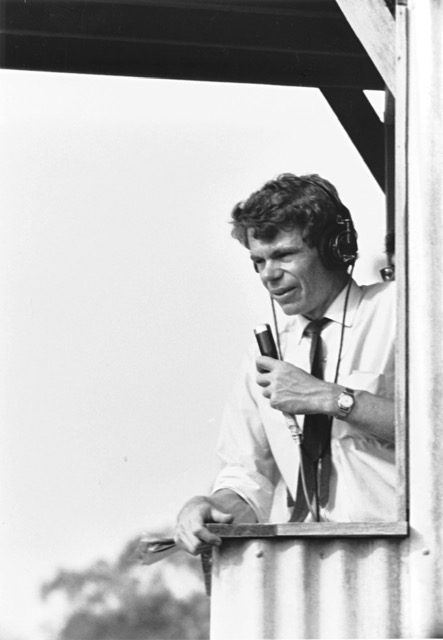by Andrew Moore – – –
Graham Howard (1937-2013) was the doyen of Australia’s motor racing historians and a highly respected journalist. Brian Caldersmith described him as ‘Our Doug Nye, Eoin Young and Denis Jenkinson all rolled into a quiet package‘. For John Medley and others he was simply ‘The Guru’.

Medley, Graham’s long-term friend – they met at Sydney University in 1955 – has written eloquently of him as a polymath of motor racing. Writing shortly after Howard’s death in Loose Fillings, a journal dedicated to recording the history and news of historic air-cooled racing cars that Graham helped start in 1999, Medley wrote:
Graham raced old racing cars, hillclimbed old racing cars, rebuilt old racing cars, worked on committees of old racing car clubs, created and initiated rules for old racing cars, was a committeeman organizing race meetings, a commentator at race meetings, on radio and on TV. He even perforce drove old cars on the road – but most of all he wrote splendidly about old racing cars and their custodians.
As this suggests, Graham Howard was both a practitioner and recorder of motor racing in Australia. Behind the wheel perhaps he is best remembered for his association with the Lotus marque. A founder of Lotus Club Australia, his sallies into historic circuit racing included driving the polished aluminium bodied ex-Alex Strachan Lotus 6 to good effect. The Lotus was his trademark car.

Nicknamed ‘Grime’, Graham was handy, as well as impecunious. He had several periods of full-time work in journalism, one with Wheels between 1986 and 1987, but for the most part survived on freelance journalism and part-time teaching at TAFE. Thus, he did much of the mechanical preparation of his race cars himself though he also knew who to approach for particular jobs and expertise. He was also a prolific writer. Graham wrote regularly for a number of journals including Racing Car News and Auto Action, the latter for 35 years. His column ‘Historical Speaking’ in Auto Action was a standout. Graham gave freely off his time and knowledge. A pioneer of historic motor racing in this country he was an early member of the Historic Sports and Racing Car Association (HSRCA), formed in 1981.

Back in the day, Graham Howard featured as a commentator for the ABC’s coverage of motor racing and was a ground announcer at motor racing tracks such as Warwick Farm. At The Farm, it often fell to Graham to squeeze himself into the small, elevated wooden commentary box at Creek Corner. It was an exciting vantage point. Extremely sharp, Creek Corner followed the circuit’s high-speed Hume Straight. More often than not, showmen like Norm Beechey would lay clouds of rubber there on their warm-up lap to stir up the crowd. Graham’s commentary box, however, was devoid of all creature comforts, including glass, let alone air conditioning. Many of us would remember how baking hot summer race meetings, like the Tasman series races, could be at that illustrious venue. Despite the rudimentary circumstances, under the ever-watchful eye of Geoff Sykes, secretary of the Australian Automobile Racing Club, Graham felt obliged to wear a tie on both practice and race days.
Graham’s biography of Lex Davison, Larger than Life, published in 2004, remains his most scholarly contribution to the literature of Australian motor racing. Resting on typically painstaking research, the time it took to appear reputedly frustrated Davison’s widow, Diana Gaze. However, the comparison in terms of quality with Almost Unknown, the subsequent ‘quickie’ written by another author about her second husband Tony Gaze, another highly significant motor racing luminary, is stark. Larger than Life remains one of Australia’s best motor racing books, to be compared with books written by David McKay, Behind the Wheel (1960) and David McKay’s Scuderia Veloce (2004), as well as several of John Smailes’ recent works, and little else.
Graham also wrote entries on motor racing individuals like Bill Thompson, Max Stewart, Harold Arthur and Lionel Van Praag for the prestigious Australian Dictionary of Biography. He generously advised other ADB authors, including the present writer, lending his biographical files and sharing his knowledge. With Stewart Wilson and others, Graham also wrote books on the Australian Touring Car Championship and the history of Australian Grand Prix races. One correspondent to an internet chat room after Graham died suggested that ‘Graham’s only fault was that his striving for written perfection meant that only one percent of his knowledge was ever published’.
Graham Howard died, aged 76, on 11 March 2013 of cancer. A well-attended testimonial lunch followed shortly afterwards at the Austrian Club in Frenchs Forest. Among the mourners was Australia’s greatest locally-based motor racing driver, Frank Matich. After his death, Graham’s friends Terry Wright and Garry Simkin, who helped him publish Loose Fillings, acquired the vast collection of research notes, photostats and other records that had sustained Graham’s motor racing writings. (Given the number of times Graham moved houses in his life it is remarkable that so much of his papers survived.)
After stints in a privately owned lock up in Chatswood and Terry’s home garage, in 2021 the Graham Howard Collection was donated to the Australian Motor Heritage Foundation at Sydney Motorsport Park in western Sydney.
The collection includes typescripts, research notes, photostats, magazine and newspaper articles, correspondence, photos, race programs, technical manuals and other ephemera. Some of the files are large, for instance those on Coopers and Frank Matich. My guess is that there are more than 3000 separate subject files containing up to 100,000 or more documents of one or more pages.
Over the last couple of years or so of working through them to fine tune an Excel spreadsheet of their contents it seems much more. Organised into separate categories for marques, engines and technical matters, motor racing administration, circuits and places, as well as individual drivers and motoring identities, they are lodged in five double-four drawer filing cabinets in the separate ’Graham Howard room’ on the ground floor of the ARDC’s former administration building at SMSP, now the archive and library of the AMHF.
The Howard collection has many highlights and items that are unlikely to be found elsewhere. One is the unpublished memoir of Tom Sulman, or part thereof. The son of the distinguished architect Sir John Sulman, Tom’s racing career began in the UK in 1936 when he built the Sulman Singer single seat race car and raced on speedway tracks in Britain. Perhaps Sulman is best remembered for his part in the Kangaroo Stable which competed in long distance sports car races in Europe in the mid 1950s. Sulman then brought the Aston Martin he had been using back home. Back in Australia, he was a regular competitor until 1970. The AARC organised a Sulman Trophy race at Warwick Farm to honour him. Tom died at the Easter race meeting at Bathurst in 1970 after a high-speed collision along Conrod Straight caused his Lotus Eleven to spear off the track and collide with a gate post. It seems, however, that even his racing debut was not without incident. Tom wrote,
In my first race my goggles were smashed, and in the next corner my eyes filled with gravel and I had to drive almost blind for the rest of the race. My pit crew poured what was thought to be water into my eyes, but proved to be fuel, so you can imagine the paid (sic) till they held me under a tap to wash it out – even then I could hardly see. The next race was a nightmare!
Sulman was often said to have aged prematurely, or rather to have looked older than he really was. The above may offer some explanation for this!
Graham Howard’s correspondence with other writers and motor racing historians is another of the collection’s highlights. One file documents his evolving relationship with the eminent British historian and journalist, Doug Nye, then actively involved with assembling the Donington collection in the UK. Initially formal but increasingly more relaxed in tone, there was regular correspondence in the 1970s and 1980s. The subjects of their letters included separate restoration projects – among them a Lotus 12 – and sundry other motor racing topics such as discussion of the whereabouts of various Ferrari Super Squalos that had been in Australia, as well as the ex-Chiron, ex-Whitehead Grand Prix Talbot. These included the OSCA that Prince Bira brought to the Australian Grand Prix Orange in 1955. Graham proffered the intriguing tidbit of information that one of the car’s subsequent owners in Australia was the crime boss Abe Saffron.
Graham and Doug Nye met in person in 1987. Nye drove him to lunch at his house, ‘hurtling down narrow lanes in some road test shopping car’. It seems, too, that Doug Nye’s wife had not been informed that they had a guest for lunch. Graham concluded that ‘as a driver and a husband, Doug was really a pretty normal guy by Oz standards’. Referring to the Australian Bicentennial, in February 1988, Nye suggested, ‘many happy returns on Oz’s birthday, as a descendant myself of a long line of convicts there’s a certain fellow feeling’.
Another highlight is a file consisting of Graham’s correspondence with Terry Walker, author of Fast Tracks, published in 1995. Here further esoterica, especially circuit diagrams of some forgotten motor racing tracks in Australia, are included. A future biographer of Frank Matich need look no further than the relevant Matich file in the Howard archive as a starting point. Other correspondence files shed light on the peccadillos and foibles of several big-name motor racers, a reminder that they, too, were human.
The Graham Howard papers are the jewel in the AMHF collection. The plan, or perhaps more accurately hope, is that along with other material in the AMHF collection, in time Graham’s papers will be digitised and accessible online.

